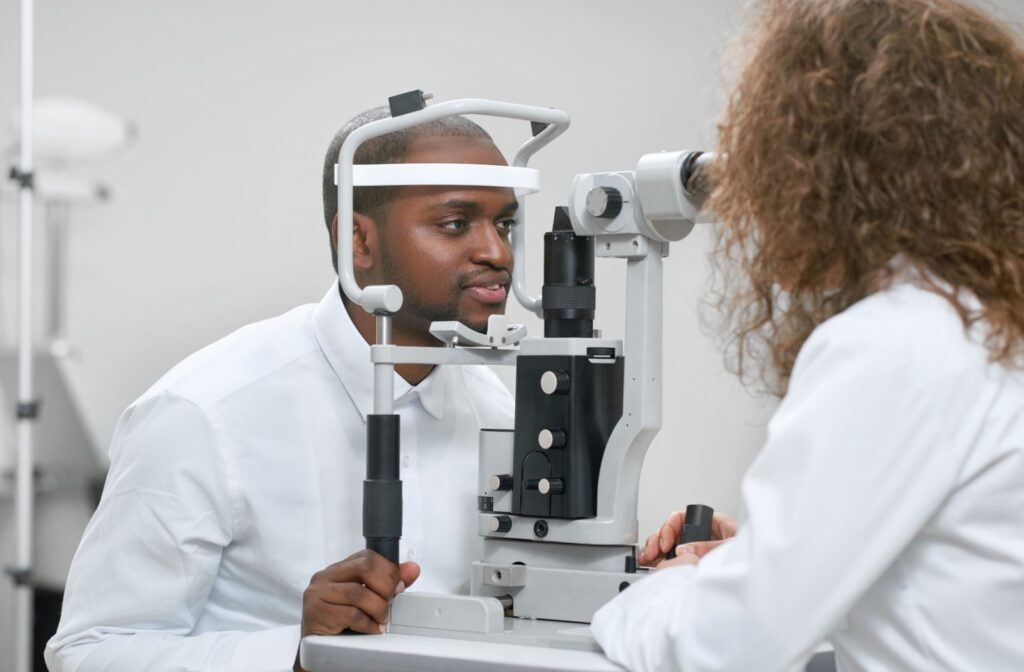If you’ve ever experienced frequent headaches, eye strain, or trouble focusing—especially after using digital screens—you might be dealing with a condition called eye misalignment.
Eye misalignment, also known as binocular vision dysfunction (BVD), occurs when your eyes struggle to work together as a team, causing a range of uncomfortable symptoms and visual fatigue.
While many people assume their symptoms are related to general tiredness or poor posture, they’re often surprised to learn that the real cause may be a subtle misalignment in the way their eyes coordinate. Thankfully, modern treatments like Neurolens can offer lasting relief.
What Is Eye Misalignment?
Eye misalignment happens when your eyes are slightly out of sync, meaning that they don’t align perfectly when you’re looking at an object. Even small misalignments can force your eye muscles to overcompensate to maintain clear and single vision. This constant effort can lead to strain, fatigue, and a host of other uncomfortable symptoms.
Eye misalignment is often referred to as binocular vision dysfunction, or BVD. In people with BVD, the eyes don’t work together in perfect harmony, which disrupts depth perception and causes discomfort during visual tasks, especially when reading, driving, or using screens.
Eye misalignment can be present from childhood or develop over time due to eye muscle weakness, head trauma, or neurological issues.
Common Symptoms of Eye Misalignment
The symptoms of eye misalignment can be wide-ranging and are often misattributed to other issues like migraines, anxiety, or neck strain. However, recognizing these signs is the first step toward getting the right diagnosis and treatment.
Here are some of the most common symptoms:
- Frequent headaches (especially around the temples or eyes)
- Eye strain or fatigue after reading or using a computer
- Blurred or double vision
- Difficulty with reading comprehension
- Light sensitivity
- Motion sickness or dizziness
- Neck and shoulder pain from head tilting
- Anxiety in crowded or busy visual environments
- Dry, irritated, or watery eyes
Some people with BVD also struggle with balance or coordination, while children may show signs like poor attention in school or avoidance of reading.
What Causes Eye Misalignment?
There are several factors that can contribute to eye misalignment. These include:
1. Congenital Eye Muscle Imbalances
Some people are born with subtle differences in how their eye muscles function. These differences may not cause issues early in life, but they can become more noticeable with age or increased visual demands.
2. Head Injuries or Concussions
Trauma to the head can disrupt the nerves and muscles that control eye movement, leading to misalignment. This is particularly common in sports injuries, falls, or car accidents.
3. Neurological Conditions
Certain neurological disorders can interfere with the brain’s ability to coordinate eye movements properly.
4. Prolonged Digital Device Use
Spending long hours on phones, tablets, and computers can fatigue the eye muscles, especially in people with pre-existing tendencies toward misalignment. Over time, this can worsen symptoms and affect your ability to focus comfortably.
How Is Eye Misalignment Diagnosed?
Eye misalignment isn’t always obvious on a standard vision test. You may have 20/20 vision but still suffer from binocular vision dysfunction. That’s why a comprehensive eye exam—including a binocular vision assessment—is key to identifying this issue.
During the exam, we’ll evaluate how well your eyes work together. Specialized equipment can detect small misalignments and help determine if your symptoms are related to BVD.

What Is Neurolens?
Neurolens is a treatment option designed specifically to relieve symptoms caused by eye misalignment. This technology uses precise measurements of how your eyes align at both near and far distances. Based on this data, your eye doctor can prescribe custom lenses with a contoured prism, which gently guide your eyes back into proper alignment.
These lenses reduce the strain your eye muscles experience trying to stay in sync, helping to alleviate many of the uncomfortable symptoms of BVD, often within just a few days of use.
Benefits of Neurolens for Eye Misalignment
Neurolens is gaining popularity among patients and eye care professionals because of its effectiveness and comfort. Here are some key benefits:
- Significant relief from headaches and eye strain
- Improved focus and reading comfort
- Reduced neck and shoulder tension
- Less screen fatigue and dry eye symptoms
- Non-invasive and easy to integrate into your daily routine
Take the First Step Toward Visual Comfort
Eye misalignment is more common than many people realize, and it can have a big impact on your daily comfort, productivity, and overall wellness. The good news is that, with the right diagnosis and treatment, you don’t have to live with chronic headaches, eye strain, or fatigue.
At Total Vision Sports Arena in San Diego, CA, we’re proud to offer solutions like Neurolens to help you find lasting relief. Whether you’re experiencing subtle discomfort or persistent symptoms, we’re here to help you see—and feel—your best.
Contact us today to schedule an eye exam and discover if Neurolens is right for you.



